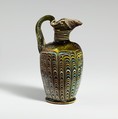Glass oinochoe (perfume jug)
Eastern Mediterranean or South Italian
Translucent green, with handle and pad-base in same color; trails in opaque yellow, opaque white, and opaque turquoise blue.
Applied trefoil rim-disk with long spout; cylindrical neck; broad rounded shoulder; slightly convex sides to body with downward taper; applied low oval pad-base with concave bottom; strap handle attached to outer edge of shoulder drawn up and round in a loop, arching above the rim-disk, and pressed onto back of rim-disk and top of neck.
A fine yellow trail attached at edge of rim-disk; another unmarvered yellow trail wound spirally six and a half times around neck; a third yellow trail, marvered, begun at edge of shoulder and wound round once in a horizontal line on body, then tooled into an inverted festoon pattern, extending to base; mingling with it in alternating lines, turquoise blue and white trails in twenty-three vertical panels with downward strokes, creating vertical ribbing on body; another unmarvered yellow trail wound round edge of pad-base.
Complete, but internal cracks and one area of repair around shoulder; slight dulling and pitting, patches of creamy iridescent weathering, and limy brown encrustation on rim-disk and part of pad-base.
In the late fourth century B.C., perfume containers often are far larger than their predecessors and have strikingly elegant decoration in the form of delicate colored threads combed into a zigzag, feather, or festoon pattern.
This image cannot be enlarged, viewed at full screen, or downloaded.

